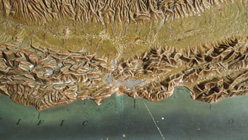Chances are you’ve never heard of it. Unless you grew up in the Bay Area, have an interest in natural water systems, or were once on a strange Sausalito-based scavenger hunt looking for a 1.5-acre hydraulic model of the San Francisco Bay and Delta, the phrase “Bay Model” triggers a giant question mark in your mind.
Built between 1956 and 1957 by the U.S. Army Corps of Engineers, the Bay Model was constructed to run a variety of tests on a fully functional model of the Bay Area’s many ship channels, rivers, creeks, sloughs, canals, fills, major wharfs, piers, slips, dikes, bridges, and breakwaters. In 2000 it morphed from active laboratory to educational center, computer modeling replacing human measurement. Today it is a rambling miniature water park within a cavernous warehouse and a great spot to while away a few information-filled hours.

On a weekday afternoon without school groups present, visiting the Bay Model feels a bit like showing up for a field trip on the wrong day. Up a ramp and through a small display on the history of the Bay Area’s watershed (the curved walls covered in wonderful and surprisingly intact paintings), a carpeted room hosts a short video detailing the Bay Model’s features and educational significance. “It’s a complicated system,” says the narrator over guitar strums, chirping birds, and the sound of flowing water.
The video provides several clips of the Model, but nothing prepares for the actual thing. Viewed from an elevated walkway, the Bay Area water system spreads below over the size of two football fields. Inside the Model, 1,000 feet is scaled down to one foot of painted concrete, adding up to a total of 286 five-ton, 12-by-12 foot slabs of painted concrete. The entire space smells lightly chlorinated.





